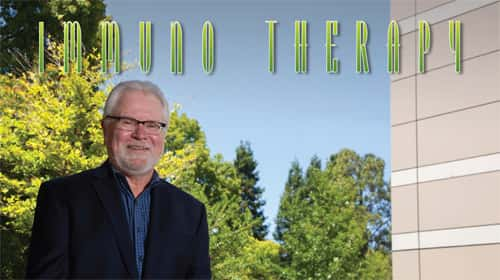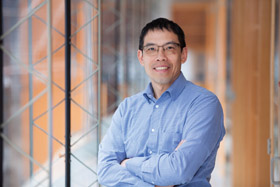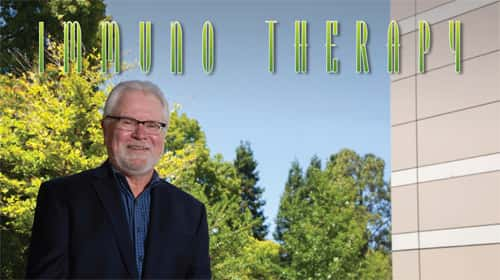 David Ebright received the news that makes your mind go blank one December day in 2013. “When somebody says ‘cancer,’ I stop listening very well,” says David, who is the public affairs manager of Kaiser Permanente Marin-Sonoma. “I want to listen, but am just not capable.” The week before, he had mentioned in the course of a routine check-up that he’d seen a drop of blood in his urine. They immediately sent him for a scan. That day, David was sitting in the urologist’s office dazed, as the doctor explained to his wife, Marsha, the treatment plan that would involve removal of the small tumor, making sure the cancer had not spread, and then a course of treatments, beginning four months later, that would arm his immune system to fight against any cancer returning to the bladder. It would be a targeted, specific approach that would enable his body to heal. The treatment: immunotherapy.
David Ebright received the news that makes your mind go blank one December day in 2013. “When somebody says ‘cancer,’ I stop listening very well,” says David, who is the public affairs manager of Kaiser Permanente Marin-Sonoma. “I want to listen, but am just not capable.” The week before, he had mentioned in the course of a routine check-up that he’d seen a drop of blood in his urine. They immediately sent him for a scan. That day, David was sitting in the urologist’s office dazed, as the doctor explained to his wife, Marsha, the treatment plan that would involve removal of the small tumor, making sure the cancer had not spread, and then a course of treatments, beginning four months later, that would arm his immune system to fight against any cancer returning to the bladder. It would be a targeted, specific approach that would enable his body to heal. The treatment: immunotherapy.
David liked the sound of it. “One of the things that appealed to me was that it didn’t sound like chemotherapy or radiation,” he says. “I also liked that it would have limited, or minimal side effects.” He also liked that his own immune system would have some responsibility in conquering his cancer. David re-engaged in the conversation. “I said, ‘Okay, let’s kick my immune system into gear. Let’s make it help me out.” What they gave him was, in fact, a kind of vaccine. “It was a form of live tuberculosis they put into my bladder,” he says.
The treatments took place in his doctor’s office, and though David missed worked on those days, he carried on with his normal life. “I started off once a week for six weeks, and then I came back and had three treatments once a month. Then I moved on to have three treatments, once a week, every six months. I did that for nearly three years.” The side effects were minimal. “The only side effect I ever had was irritation in my bladder. After the first half dozen treatments, I didn’t experience any side effects. And then I developed an increasing irritation to the treatment.”
In television and print advertisements, immunotherapy is often portrayed as a new, discovery that lets your body do the work of getting rid of your cancer, so you can get back to leading a long, healthy life. The ads portray immunotherapy as a cymbal-crashing miracle. Is it? What is immunotherapy? Here’s an overview of immunotherapy, how it works and what specialists have to say about this revolutionary new treatment.
How it works
 Daniel Maloney, M.D., chief of oncology at Kaiser Permanente in San Rafael, has a simple approach to explaining the science behind the treatment. “The way I describe immunotherapy to people is like this: We’ll have a cancer cell floating around. The immune system will target that cancer cell and kills it. But cancer cells evolve over time, get pretty smart, put on a disguise, and the immune system gives them a hall pass. Then you’re at risk for developing cancer.” The cancer cell—which is not an invader from outside the body, like a virus or bacteria, but one of our own cells—erroneously programmed to keep on growing and spreading, puts up a shield that prevents the immune system from identifying it as rogue. The immune system overlooks it, and the cancer continues to grow. The science of immunotherapy is about equipping the immune system with specific tools to detect and attack a specific cancer. It is, if not miraculous, a revolutionary way of treating the disease. “Immunotherapy has changed the field of oncology,” says Maloney.
Daniel Maloney, M.D., chief of oncology at Kaiser Permanente in San Rafael, has a simple approach to explaining the science behind the treatment. “The way I describe immunotherapy to people is like this: We’ll have a cancer cell floating around. The immune system will target that cancer cell and kills it. But cancer cells evolve over time, get pretty smart, put on a disguise, and the immune system gives them a hall pass. Then you’re at risk for developing cancer.” The cancer cell—which is not an invader from outside the body, like a virus or bacteria, but one of our own cells—erroneously programmed to keep on growing and spreading, puts up a shield that prevents the immune system from identifying it as rogue. The immune system overlooks it, and the cancer continues to grow. The science of immunotherapy is about equipping the immune system with specific tools to detect and attack a specific cancer. It is, if not miraculous, a revolutionary way of treating the disease. “Immunotherapy has changed the field of oncology,” says Maloney.
How does immunotherapy differ from chemotherapy? Chemotherapy is a systemic therapy, he explains. It sends a toxin through your veins to fight all the cells that are rapidly dividing, such as cancer cells. “The idea is to kill more bad guys than good guys,” he says. The strategy is general and with the treatment comes the dreaded side effects such as hair loss and vomiting.
“These immunotherapy drugs have changed the world of oncology,” says Maloney. “They remove that disguise, letting the immune system detect and kill the cancer. That’s how they work. So now you have a focused type of therapy to target the cancer.”
Is it the miracle cure for cancer? “There’s no free lunch, especially for immunotherapies,” he says. You could think of the immune system as an army, geared up to fight, and super-charged with the immunotherapy drugs to fight a particular cancer. As with such a force, there can be risks. “You now have an immune system that is amped up and can turn right around and go after you, and cause inflammation of various organs,” says Maloney. “We’re getting better at dealing with side effects.” While immunotherapy may sound simple, it’s not.
An evolving science
Advances in immunotherapy have had a continual impact on how physicians help patients with cancer, bringing a complex mix of challenges and successes, says Barbara Galligan, M.D., an oncologist at Marin Cancer Center.
“Immunotherapy means a lot of different things,” she says. For example, the Food and Drug Administration (FDA) has approved immunotherapy for use on only some cancers, including metastatic melanoma, lung cancers, bladder cancer and others. “These are new, expensive, drugs that are promoted with direct-to-consumer advertising campaigns resulting in patients coming in to their doctors asking for immunotherapy.”
“Immunotherapy doesn’t work on every cancer, says Galligan. “Or, it may not be the right time for immunotherapy. There are times over the course of someone’s treatment where immunotherapy may or may not be useful.” She explains some of the complex conditions behind the miraculous-appearing results portrayed on ads.
“The thing about immunotherapy is that if you have a great response, it looks like a true miracle drug,” says Galligan. For example, there are people whose cancers such as a deadly metastasized melanoma, have disappeared for years after treatment with immunotherapy. “But the flip side is that there are patients who won’t respond,” she adds. Current statistics place the responders (those who show lasting improvement) in the neighborhood of 20 to 30 percent. This means there are a great many for whom the drug, no matter how seemingly miraculous for others, does not work.
Why don’t all patients respond? “We’re learning that cancer is not just one disease,” says Galligan. “It’s many diseases. And even within one cancer type (lung cancer, for example), there are many different types.” According to Galligan, it’s important to take a sample of a patient’s tumor to take a closer look at the biology. “If you take a sample and study it, you can see the differences,” she says. “The closer you look at the biology, [you note] there’s a lot of variability.” One patient’s lung cancer may not be the same as another patient’s lung cancer. “That’s what predicts [a patient’s] response to immunotherapy.”
Another complication is that the cancer’s “disguise” can be outsmarted by the immunotherapy drug, but the cancer may mutate and outsmart it back. As a result, says Galligan, you may need to change treatment to select for new mutants that are not going to go away with prior treatments.
Currently, medical science is working to find ways to predict whether cancer patients will respond to immunotherapy. “That’s a nascent field and I hope it gets better every year,” says Galligan. Some patients are set on immunotherapy, and are frustrated when they hear that it might not be the right treatment for them at the time, she adds. When preparing for treatment, she says, the best approach is to find a doctor who will support you. “It’s important to find an open-minded, enthusiastic oncologist and to establish a good doctor-patient relationship, one with communication and trust, because the field is complex, and [immunotherapy] is not one-size-fits all,” she says.
Working with the immune system
 Looking for treatments that support the immune system isn’t new in the field of medical science. Lawrence Fong, M.D., co-leader of the cancer immunotherapy program at the University of California San Francisco (UCSF) offers a perspective. “A hundred years ago, Dr. William Coley, a surgeon at New York Cancer Hospital [later known as Memorial Sloan Kettering] was using bacteria to treat cancer patients on the theory that the immune system could be stimulated with bacteria,” he says. At that time, the treatment was imperfect and some patients would’ve become infected with the bacterial infection. Says Fong, "People look back to him as one of the earliest doctors, thinking about using the immune system to treat cancer.”
Looking for treatments that support the immune system isn’t new in the field of medical science. Lawrence Fong, M.D., co-leader of the cancer immunotherapy program at the University of California San Francisco (UCSF) offers a perspective. “A hundred years ago, Dr. William Coley, a surgeon at New York Cancer Hospital [later known as Memorial Sloan Kettering] was using bacteria to treat cancer patients on the theory that the immune system could be stimulated with bacteria,” he says. At that time, the treatment was imperfect and some patients would’ve become infected with the bacterial infection. Says Fong, "People look back to him as one of the earliest doctors, thinking about using the immune system to treat cancer.”
The bacteria used to treat David Ebright’s bladder cancer was an attenuated strain of tuberculosis, called BCG, developed in the 1970s, which uses the bacterium to stimulate an immune response in the bladder.
“In fact, we continue to use that as front line therapy for non-muscle invasive bladder cancer,” says Fong. “That is the longest ongoing FDA-approved cancer therapy being used now to fight the cancer.”
The complexity of cancer
Cancers can arise from different tissues in our bodies, Dr. Fong explains, and each one of those tissues may have characteristics that are unique to it. “For example, breast cancer arises from very different tissues from, say, a colon cancer. In addition to the cells that these cancers would arise from, there are also potentially different causes that might have led to a cancer. As a result, because these origins are different and the tissues are different, you may need different treatments for each of those.” Every cancer, like every person, is unique.
Like any treatment, there are side effects, but according to Fong they show up differently. “The side effects we see are a bit different from what we see with conventional cancer therapies,” says Fong. “Usually, with conventional cancer therapies, the side effects occur as you’re receiving the treatment, or in some cases, there might be a delay of a week or two, in terms of being susceptible to infection. With immunotherapy, the side effects we see may take three to six months to manifest and may include inflammation of particular tissues in our bodies, such as a skin rash, or inflammation in the endocrine glands such as thyroid or pancreas. These are examples where there can be loss of hormone function, not unlike those in autoimmune diseases.
The cost
While the cost depends on the insurance coverage, says Fong, prices begin in the low six figures and can go higher. Like all pharmaceutical products, the science behind immunotherapy took a lot of time to research, test, create the drugs and conduct clinical trials, a process than can take years. “So when you think of a treatment for melanoma, it took between three and five years of clinical studies to show it improved survival,” he says. “And that required treating more than 1,000 patients.”
UCSF has a team that fronts clinical studies, and those studies may be involved in getting FDA drug approval. There are also teams looking at how immunotherapies work, and they’re trying to develop new treatments. Says Fong, “We’re at a unique crossroads where we can treat the patients, but we can also learn from them how these treatments work or don’t work.”
Looking ahead
The future of immunotherapy looks promising, Fong says. “With immunotherapy, what we’re finding is rather than a patient responding while [undergoing] treatments, we found the patient can have a durable response with immunotherapy. In fact, it’s to the point where we’re thinking that some cancer patients can be cured with immunotherapy.”
Cured? “As an oncologist, we don’t’ use [the term] ‘cure’ lightly,” he says carefully. “The critical part now is that we follow our patients who’ve responded to immunotherapy and we may find that some of these patients are indeed cured.” They’re looking at time in years, instead of months, with a disease which, 10 years ago, would’ve have been considered terminal.”
Though the response statistics are fairly low, researchers and oncologists are seeing more good responses, and longer times in remission and people like David Ebright are enjoying years of cancer-free living. “What excites me most is that we’re seeing so many different cancers respond to immunotherapy, and we’re seeing patients have durable responses, which are unprecedented,” says Fong. “Right now, only a small minority of patients benefit from these immunotherapies—around 20 percent. What gets us excited is how do we make that 20 percent turn into 40 percent or 80 percent? That’s what’s exciting now. We know immunotherapies can work, but now it’s trying to get them to work in more people.”
From Galligan, the excitement is in watching her own patients. “It’s a phenomenal field that has changed the way we treat cancer,” she adds. “It’s not for every patient and for every cancer type, but the number of indications and the number of cancers it can be used for is growing every day.” The most important thing is to have a good doctor-patient relationship, she says. “Treating cancer is complex. You have to work together as a team to come up with the best treatment.”
“It’s important for people to know that every day we’re making significant strides towards treating cancer in a more focused fashion with the ultimate goal of curing it,” says Maloney. “That’s a long shot, but that’s the goal.”
Hope for the future
As for David Ebright, his treatments have ended and he remains cancer free. “The thing about cancer, apparently, is where it is and how much it has spread,” he says. “For me it was only in the lining of my bladder. It hadn’t moved into any muscle or any other organs. How [immunotherapy] works, I’m not exactly clear. That it does—I’m happy about it. Now, I go in every six months for a checkup. And my urologist says, ‘Nope, I don’t see anything.’ And I think it’s just going to continue that way.”
What David learned from his experience centers around awareness, action and trust. “If something looks suspicious, don’t linger or lapse into denial, because it’s not necessarily as scary as it used to be,” he advises. Immunotherapy, he says, along with the support of his medical team, family and friends, was a big, if mysterious, part of a good outcome. He also credits the pre-surgery guided meditations available online through Kaiser as helping him through the process. “I used them regularly; they calmed me and helped the healing process, too.”
Meanwhile, David is back to his usual daily routine and embracing life. “I’m looking forward to more of it,” he says. “I feel good, fit and healthy and I strive to keep it that way. Fun remains one of my core values and my gratitude list grows daily.”




